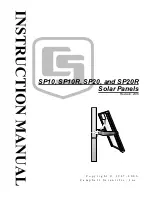
Battery Charge Controller
11-1890-0
General Info
How do solar cells generate electricity?
Solar panels, also known as photovoltaics (PV), can
be thought of as a direct current (DC) generator
powered by the sun. When light photos of
sufficient energy strike a solar cell, they “knock”
electrons free in the structure forcing them
through an external circuit (battery or direct DC
load), and then returning them to the other side
of the solar cell to start the process all over
again.
Will solar panels work in my location?
Solar panels work in any outdoor location depending
on the irradiance. Irradiance is a measure of the
sun’s power available at the surface of the earth
and it averages about 1000 W/m2.
What is the difference between amorphous
and polycrystalline cells?
These panels are amorphous solar panels.
Amorphous solar panels contain no cells, but
are created through a deposition process that
actually forms the silicon material directly on
the glass substrate. Amorphous panels are
made up of an interconnecting “thin-film” of
laser-patterned silicon. The amount of silicon
used is up to a 100 times thinner than that of a
polycrystalline cells. Amorphous panels are
better at generating electricity.
Installation of Multiple
Panels
Eliminator Power Panel Instructions
Installation
Connection to a battery:
Attach the Battery Charge Controller
positive (+) wire to the positive (+)
battery terminal. Then connect the
Battery Charge Controller negative
(-) wire to the negative (-) battery
terminal. WARNING: The clips
MUST be placed on to the battery in
the aforementioned order—wrong
connections may cause sparking or
explosion.
Connect to Solar Panel:
Strip the solar panel wires. Connect
positive (+) to positive (+) and
negative (-) to negative (-). Ensure
the connections are secure.
Operation:
Green light indicates a full-charged
battery. When the battery reaches
14.2 V, the Battery Charge
Controller will cutout voltage
thereby ensuring no overcharging.
Yellow light indicates a battery that
is being charged. When the battery
reaches 13 V, the Battery Charge
Controller will cut-in and charging
will begin.
Installation of Multiple Panels:
• Use the included connector plug
which quick connects striped wires
to each 15W utilized
• Join all positive wires and all
negative wires. Ensure all
connections are tight. Use of
included wire nut connector.
Insulating materials may also
prove helpful.
• Keep positive to positive and
negative to negative to ensure
12V usage
• Use a 7 Amp Solar Charge
Controller to prevent Battery
Overcharge
FAQ
1. How many panels can I connect to my 7 Amp
Solar Charge Controller?
A. You can connect up to 105 Watts of Solar Power
to the 7 Amp Solar Charge Controller. Panels
should be connected in parallel – positive to
positive, negative to negative.
2. When will the Charging Indication light (green)
light up?
A. The charging controller indication green light will
light up when the battery voltage reaches 14.2
Volts and the SCC will prevent the solar panels
from overcharging the battery. It is normal for
the SCC LED to light on and off as the battery
voltage cuts in and out.
5-year Warranty
This Motomaster
®
Eliminator product carries
a
five (5) year
warranty
against defects in
workmanship and
materials. Motomaster
®
Canada agrees to replace
the defective product free
of charge, within the stated
warranty period, when
returned by the original
purchaser with
proof of
purchase
. This product is
not guaranteed against
wear or breakage due to
misuse and/or abuse.
NOTES:
• It is normal for both lights to flicker on and off
during normal operation. The Battery Charge
Controller should be placed within 5’ of the battery
in a dry, well-ventilated area. This Battery Charge
Controller can support up to 100 W and up to 7 A of
array current. All connections should be parallel to
ensure 12 V (positive to positive and negative to
negative).
GENERAL TESTING PROTOCOL
Alway s test outdoors under optimal
sunlight conditions.
A. Test Solar Panels for Voltage.
Connect Voltmeter to each indiv idual
panel separately and observ e Open
Voltage. Open Voltage can range f rom
16 Volts to 24 Volts. Once all panels test
f or v oltage, proceed to step B.
B. Test Connection to Charge Controller
for Voltage.
Reconnect Solar Panels, and connect to
charge controller as per instructions.
Measure open circuit Voltage at the
battery side of the charge controller.
Open circuit v oltage should read 5-10%
lower than without charge controller.
Open circuit measurement will read
between 15 and 23.5.
C. Connect charge controller to battery
First, disconnect solar panels and
connect charge controller to battery .
Alway s connect charge controller to
battery f irst and remov e last. Observ e
polarity – positiv e to positiv e and
negativ e to negativ e.
D. Reconnect Solar Panels to Charge
Controller.
If battery v oltage is 14.2 or higher, the
GREEN light should be on. If battery
v oltage is between 13 and 14.2, the
Y ELLOW LED should be on.
If battery v oltage is 13 or lower, the
Y ELLOW LED should be on.
If all testing results within the abov e
indicated ranges, solar sy stem is in
acceptable range. If Voltage reading
indicate lower ranges, repeat abov e
connections and retest. Finally , it is
common to hav e 12V Battery issues
such as dead cells or non-rechargeable
battery problems.
SOLAR
SOLAR
PANEL
SOLAR
PANEL
READ this manual BEFORE and
DURING the use of this product.




















